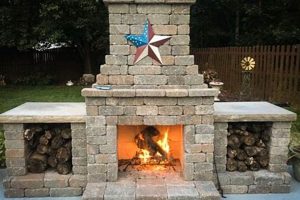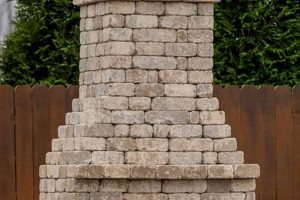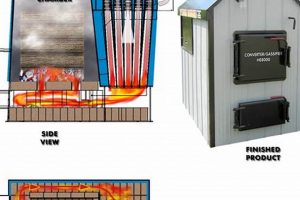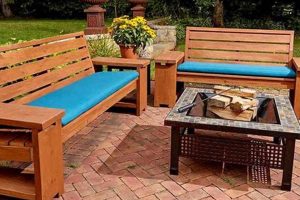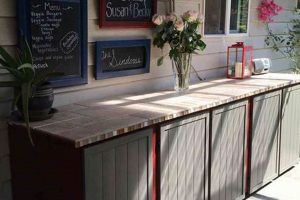The construction of customized exterior beverage stations represents a growing trend in residential design. These structures, typically built by homeowners or hired contractors, serve as dedicated spaces for preparing and serving drinks in an outdoor environment, extending entertaining possibilities beyond the confines of the indoor kitchen or dining area. An example would be a repurposed wooden pallet transformed into a functional bar with shelves for glassware and liquor bottles.
Creating such a space enhances the functionality and aesthetic appeal of patios, decks, and backyards. Functionality is improved by providing a designated area for drink preparation, thereby reducing traffic in the main house during social gatherings. The addition also holds potential for increased property value through the addition of an appealing outdoor amenity. Historically, the concept reflects a modern adaptation of the home bar, tailored for al fresco enjoyment.
Subsequently, relevant topics to explore include cost-effective construction methods, material selection for weather resistance, spatial planning considerations for optimal functionality, and design styles that complement existing landscape architecture.
Construction Guidance
The following guidelines offer practical advice for building personalized exterior beverage stations, emphasizing durability and functionality.
Tip 1: Material Selection: Prioritize weather-resistant materials. Treated lumber, cedar, or composite decking withstand outdoor conditions, resisting rot and insect damage. For countertops, consider concrete, tile, or sealed granite for durability and easy cleaning.
Tip 2: Structural Integrity: Ensure a solid foundation. If building on uneven ground, level the area and use concrete footings to prevent settling or shifting. Proper framing techniques are crucial for a stable and long-lasting structure.
Tip 3: Plumbing Considerations: Plan for water lines if incorporating a sink. Consult a licensed plumber for proper installation to avoid leaks and ensure compliance with local codes. Include a drainage system for wastewater disposal.
Tip 4: Electrical Planning: Integrate electrical outlets for appliances such as blenders, refrigerators, or lighting. Engage a qualified electrician to wire the station safely and according to regulations. Ground Fault Circuit Interrupters (GFCIs) are essential for outdoor electrical safety.
Tip 5: Spatial Optimization: Design the station with workflow in mind. Allocate sufficient counter space for drink preparation and serving. Include designated storage for glassware, utensils, and beverages.
Tip 6: Shade and Protection: Incorporate a roof, awning, or umbrella to protect the station from direct sunlight and rain. This extends the lifespan of materials and provides comfort for users.
Tip 7: Appliance Integration: Choose appliances suitable for outdoor use. Outdoor refrigerators and ice makers are designed to withstand varying temperatures and humidity levels. Ensure adequate ventilation for heat-generating appliances.
Adhering to these suggestions promotes the creation of a functional and enduring outdoor amenity. By prioritizing appropriate construction techniques, lasting resources are created.
Subsequently, explore relevant styles that complement existing landscape architecture for building personalized exterior beverage stations.
1. Budget
Budgetary considerations exert a primary influence on the feasibility and scope of exterior beverage station projects. Financial constraints directly affect material selection, design complexity, and the inclusion of desired amenities, thereby dictating the final product’s quality and functionality.
- Material Selection Based on Cost
The budget fundamentally shapes the range of viable material options. High-end materials, such as stainless steel or premium hardwoods, offer increased durability and aesthetic appeal but come at a higher cost. Conversely, more affordable alternatives like treated lumber or repurposed materials offer a cost-effective solution, requiring a trade-off between longevity and initial investment. For example, using reclaimed wood pallets can significantly lower costs compared to purchasing new lumber.
- Scope of the Project
The budget defines the extent of the project. A limited budget may necessitate a smaller structure with fewer features, such as basic shelving and a countertop. A larger budget allows for the incorporation of amenities like built-in refrigerators, sinks with running water, or elaborate lighting systems. An individual working with a smaller budget might choose a simple bar cart while someone with a larger one might build a fully equipped outdoor kitchen.
- Labor and Professional Services
A significant portion of the budget may be allocated to labor costs if professional assistance is required. Hiring contractors for plumbing, electrical work, or custom carpentry increases expenses. Performing these tasks independently can reduce costs but necessitates possessing the relevant skills and knowledge. A skilled homeowner might handle carpentry while subcontracting electrical work to ensure safety and code compliance.
- Long-Term Maintenance Costs
Budgetary planning should account for long-term maintenance expenses. Lower-cost materials may require more frequent repairs or replacements, resulting in increased costs over time. Investing in durable, weather-resistant materials can minimize maintenance needs and overall lifecycle costs. Choosing durable materials for an outdoor bar can result in savings by reducing repairs.
Ultimately, a clearly defined and adhered-to budget ensures that the final exterior beverage station aligns with financial resources while meeting the desired functional and aesthetic requirements. Careful planning, strategic material selection, and a realistic assessment of labor needs are essential for maximizing value and minimizing unexpected expenses.
2. Materials
Material selection directly determines the longevity, aesthetic appeal, and overall functionality of exterior beverage stations. The interplay between environmental exposure and material properties dictates structural integrity and maintenance requirements. For instance, untreated wood is susceptible to rot and insect infestation, necessitating frequent repairs or premature replacement. In contrast, materials like stainless steel or treated lumber offer superior resistance to weather-related degradation, extending the lifespan of the structure. The implementation of durable resources are paramount to the creation of lasting structures.
Consider the example of a bar constructed from reclaimed wood pallets. While economically advantageous, these materials may exhibit varying degrees of structural soundness and require extensive preparation, including sanding and sealing, to ensure a safe and visually appealing surface. Conversely, utilizing composite decking material eliminates the need for painting or staining and resists moisture damage, simplifying maintenance and prolonging the station’s usability. The decision to incorporate a concrete countertop introduces a durable, heat-resistant surface, albeit at the expense of increased weight and installation complexity. Appropriate planning can produce aesthetically pleasing results.
In summary, the choice of materials represents a fundamental aspect of exterior beverage station construction, influencing both short-term costs and long-term performance. Proper consideration of weather resistance, structural integrity, and aesthetic compatibility is essential for achieving a durable, functional, and visually appealing outdoor amenity. Challenges arise in balancing budget constraints with the need for quality materials that withstand environmental stressors, thereby necessitating careful planning and informed decision-making.
3. Functionality
Functionality constitutes a foundational element in the design and construction of exterior beverage stations. The practical utility of such a structure dictates its overall success, impacting user experience and the efficiency of outdoor entertaining. Lack of thoughtful consideration for functionality results in a space that is cumbersome to use, detracting from the intended purpose. For instance, an outdoor bar without adequate counter space hinders drink preparation, while insufficient storage complicates organization and access to necessary tools and supplies. The cause-and-effect relationship between thoughtful design and practical usability is direct and demonstrable. Consider a bar design incorporating a built-in ice cooler; its inclusion directly enhances the station’s capacity to serve chilled beverages, a key functional requirement for outdoor entertaining. This direct increase in usefulness shows its importance.
Real-life examples further underscore this point. A station positioned far from the house, lacking running water, necessitates frequent trips indoors for refills and cleaning, diminishing its practicality. Conversely, a well-designed station incorporates strategic placement near the house, ample counter space, and accessible water lines, streamlining drink preparation and minimizing inconvenience. Therefore, understanding the practical significance of functionality enables homeowners to make informed design choices that maximize the utility of the space. An example of this comes from a home owner, who having built one bar, was able to build another far more effecient and useful bar for outdoor hosting.
In summary, functionality should be a driving consideration in the creation of exterior beverage stations. Prioritizing practical utility through strategic design choices translates to a more efficient, enjoyable, and ultimately successful outdoor entertaining space. Challenges may arise in balancing aesthetic preferences with functional requirements, necessitating careful planning and a clear understanding of the intended use of the station. It should be the purpose of the project to meet expectations and offer a premium, useful, function focused station.
4. Location
The placement of exterior beverage stations directly influences their functionality and overall integration with the existing outdoor environment. Proximity to the main residence impacts convenience in terms of access to utilities, such as water and electricity, as well as the ease of transporting supplies and refreshments. Strategic placement leverages pre-existing features, such as patios, decks, or landscaping elements, to create a cohesive and aesthetically pleasing outdoor space. For example, constructing a station adjacent to an outdoor kitchen area or near a swimming pool integrates it seamlessly into the broader outdoor living area, enhancing its utility and accessibility.
Considerations extend beyond mere convenience and aesthetics. Site selection must account for environmental factors, including sun exposure, prevailing winds, and drainage patterns. Positioning a station in direct sunlight can render it unusable during peak hours, while exposure to strong winds may necessitate windbreaks or protective structures. Insufficient drainage can lead to water damage and structural instability. A real-world example of poor location planning involves a station built in a low-lying area prone to flooding, resulting in repeated damage and eventual abandonment. Careful site assessment mitigates these risks, ensuring long-term usability and structural integrity.
In summary, location represents a critical determinant in the success of exterior beverage station projects. Thoughtful site selection balances convenience, aesthetics, and environmental considerations to create a functional and enjoyable outdoor amenity. Addressing potential challenges, such as utility access and weather exposure, ensures the long-term usability and value of the investment. Its a vital and key factor.
5. Style
The aesthetic presentation of exterior beverage stations significantly impacts their integration into the existing landscape and overall visual appeal. Style functions as a defining characteristic, influencing the choice of materials, architectural design, and decorative elements. The selection of a particular style, whether rustic, modern, tropical, or traditional, determines the character of the station and its compatibility with the surrounding environment. Mismatched stylistic choices diminish the aesthetic coherence of the outdoor space, creating a visually jarring effect. For instance, a sleek, minimalist bar constructed from stainless steel and glass would appear incongruous in a garden dominated by natural stone and weathered wood. Appropriate style selection is critical to creating a unified and visually pleasing outdoor environment.
Consider the practical application of different styles. A rustic bar constructed from reclaimed wood and featuring exposed brick accents complements a natural, informal garden setting. In contrast, a modern bar incorporating clean lines, geometric shapes, and minimalist dcor would be more appropriate for a contemporary outdoor space. The incorporation of thematic elements, such as tiki carvings for a tropical style or nautical accents for a coastal theme, further enhances the aesthetic impact of the station. For example, a homeowner with a pre-existing Southwestern-style patio might construct a bar using adobe bricks and incorporating desert landscaping to maintain stylistic consistency.
In summary, style serves as an essential component in the design and construction of exterior beverage stations, influencing both aesthetic appeal and integration with the surrounding environment. Thoughtful consideration of stylistic choices ensures visual coherence and enhances the overall outdoor experience. Balancing personal preferences with the existing landscape architecture presents a challenge, requiring careful planning and an understanding of design principles. Adherence to design principles assures that there will be visual harmony.
Frequently Asked Questions
The following section addresses common inquiries regarding the design, construction, and maintenance of exterior beverage stations. These questions are intended to provide clarity and guidance for individuals undertaking such projects.
Question 1: What are the primary factors influencing the total cost of an exterior beverage station?
Material selection, the inclusion of plumbing and electrical features, and the necessity of professional labor all contribute significantly to the overall expense. High-end materials, extensive utility work, and contracted labor increase costs.
Question 2: Which materials offer the greatest durability and weather resistance for outdoor bar construction?
Treated lumber, cedar, composite decking, stainless steel, and sealed concrete provide superior resistance to moisture, insect damage, and UV degradation. These materials minimize maintenance requirements and extend the lifespan of the structure.
Question 3: Is it necessary to obtain building permits for constructing an outdoor bar?
Local building codes and regulations vary. It is advisable to consult with the relevant municipal authorities to determine permit requirements and ensure compliance with zoning laws and safety standards. Ignoring permit requirements can lead to fines or necessitate the removal of the structure.
Question 4: How can the risk of electrical hazards be minimized when incorporating electrical outlets into an outdoor bar?
Employ a qualified electrician to perform all electrical work. Ensure compliance with local electrical codes and utilize Ground Fault Circuit Interrupters (GFCIs) to prevent electrical shock in wet environments. Regular inspections of wiring and outlets are recommended.
Question 5: What are the key considerations when planning for plumbing in an outdoor bar?
Proper drainage, backflow prevention, and compliance with plumbing codes are essential. Consult a licensed plumber to ensure correct installation and to prevent leaks or contamination of the water supply. Winterization procedures may be necessary in colder climates.
Question 6: How can an outdoor bar be designed to maximize functionality and minimize wasted space?
Careful planning of storage areas, counter space, and appliance placement is critical. Consider the intended use of the station and tailor the design to meet those specific needs. Modular designs and multi-purpose features can optimize space utilization.
The information presented in this FAQ section offers a foundation for informed decision-making related to exterior beverage station projects. Further research and consultation with professionals may be necessary based on individual circumstances and project complexity.
The following article is on the best ways to protect a DIY outdoor bar.
Summary
The preceding exploration of “diy outdoor bar ideas” underscores the multifaceted nature of creating functional and aesthetically integrated outdoor spaces. From budgetary considerations and material selection to functionality, location, and stylistic harmony, each element contributes to the success of the project. Strategic planning and informed decision-making are essential for realizing a durable and visually appealing amenity.
The principles and insights presented serve as a foundation for undertaking the construction of exterior beverage stations. Continued diligence in researching local regulations, consulting with qualified professionals, and prioritizing safety ensures a responsible and rewarding outcome. This exploration is an invitation to cultivate well-designed and thoughtfully constructed outdoor living spaces.



